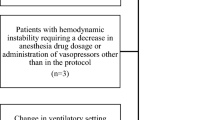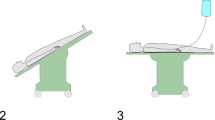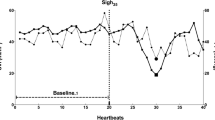Abstract
Objective
To evaluate whether arterial pressure response during a Valsalva maneuver could predict fluid responsiveness in spontaneously breathing patients.
Design and setting
Prospective clinical study in a 17-bed multidisciplinary intensive care unit.
Patients
Thirty patients without mechanical ventilation and equipped with a radial arterial catheter for whom the decision to give fluids was taken due to suspected hypovolemia.
Intervention
A 10-s Valsalva maneuver was performed before and after volume expansion (VE). Patients were classified as responders if stroke volume index (SVi) increased ≥15% after VE.
Measurements and results
Pulse pressure changes during the Valsalva maneuver (∆VPP) were calculated as the difference between maximal pulse pressure during phase 1 and minimal pulse pressure during phase 2 of the Valsalva maneuver divided by the mean of the two values and expressed as a percentage. Valsalva changes in systolic pressure (∆VSP) were calculated in similar way. SVi changes induced by VE was correlated with baseline values of ∆VPP and ∆VSP (r 2 = 0.71 and r 2 = 0.60; P < 0.0001, respectively), and with VE-induced changes in ∆VPP and ∆VSP (r 2 = 0.56 and r 2 = 0.44; P < 0.0001 and P < 0.001, respectively). A ∆VPP value of 52% and ∆VSP of 30% predicted fluid responsiveness with a sensitivity of 91% and 73% and a specificity of 95 and 90%, respectively.
Conclusions
Arterial response during the Valsalva maneuver is a feasible tool for predicting fluid responsiveness in patients without mechanical ventilatory support.






Similar content being viewed by others
References
Michard F, Teboul JL (2002) Predicting fluid responsiveness in ICU patients: a critical analysis of the evidence. Chest 121:2000–2008
De Backer D, Pinsky MR (2007) Can one predict fluid responsiveness in spontaneously breathing patients? Intensive Care Med 33:1111–1113
Heenen S, De Backer D, Vincent JL (2006) How can the response to volume expansion in patients with spontaneous respiratory movements be predicted? Crit Care 10:R102
Boulain T, Achard JM, Teboul JL, Richard C, Perrotin D, Ginies G (2002) Changes in BP induced by passive leg raising predict response to fluid loading in critically ill patients. Chest 121:1245–1252
Monnet X, Rienzo M, Osman D, Anguel N, Richard C, Pinsky MR, Teboul JL (2006) Passive leg raising predicts fluid responsiveness in the critically ill. Crit Care Med 34:1402–1407
Lamia B, Ochagavia A, Monnet X, Chemla D, Richard C, Teboul JL (2007) Echocardiographic prediction of volume responsiveness in critically ill patients with spontaneously breathing activity. Intensive Care Med 33:1125–1132
De Backer D (2006) Can passive leg raising be used to guide fluid administration? Crit Care 10:170
Felker GM, Cuculich PS, Gheorghiade M (2006) The Valsalva maneuver: a bedside “biomarker” for heart failure. Am J Med 119:117–122
Zema MJ, Caccavano M, Kligfield P (1983) Detection of left ventricular dysfunction in ambulatory subjects with the bedside Valsalva maneuver. Am J Med 75:241–248
Remmen JJ, Aengevaeren WR, Verheugt FW, Jansen RW (2006) Detection of elevated pulmonary capillary wedge pressure in elderly patients with various cardiac disorders by the Valsalva manoeuvre. Clin Sci Lond 111:153–162
Weilenmann D, Rickli H, Follath F, Kiowski W, Brunner-La Rocca HP (2002) Noninvasive evaluation of pulmonary capillary wedge pressure by BP response to the Valsalva maneuver. Chest 122:140–145
Brunner-La Rocca HP, Weilenmann D, Rickli H, Follath F, Kiowski W (1999) Is blood pressure response to the Valsalva maneuver related to neurohormones, exercise capacity, and clinical findings in heart failure? Chest 116:861–867
Parisi AF, Harrington JJ, Askenazi J, Pratt RC, McIntyre KM (1976) Echocardiographic evaluation of the Valsalva Maneuver in healthy subjects and patients with and without heart failure. Circulation 54:921–927
Korner PI, Tonkin AM, Uther JB (1976) Reflex and mechanical circulatory effects of graded Valsalva maneuvers in normal man. J Appl Physiol 40:434–440
Stewart JM, Montgomery LD (2005) Reciprocal splanchnic-thoracic blood volume changes during the Valsalva maneuver. Am J Physiol Heart Circ Physiol 288:H752–H758
McIntyre KM, Scharf SM, Parisi AF (1989) The use of Valsalva and Mueller maneuvers as diagnostic tests for coronary artery disease. In: S SM, Cassidy SS (eds) Heart-lung interactions in health and disease. Marcel Dekker, New York, pp 1021–1046
De Lee GJ, Matthews MB, Sharpey-Schafer EP (1954) The effect of the Valsalva manoeuver on the systemic and pulmonary arterial pressure in man. Br Heart J 16:311–316
Judson WE, Hatcher JD, Wilkins RW (1955) Blood pressure responses to the Valsalva maneuver in cardiac patients with and without congestive failure. Circulation 11:889–899
Michard F, Boussat S, Chemla D, Anguel N, Mercat A, Lecarpentier Y, Richard C, Pinsky MR, Teboul JL (2000) Relation between respiratory changes in arterial pulse pressure and fluid responsiveness in septic patients with acute circulatory failure. Am J Respir Crit Care Med 162:134–138
Tavernier B, Makhotine O, Lebuffe G, Dupont J, Scherpereel P (1998) Systolic pressure variation as a guide to fluid therapy in patients with sepsis-induced hypotension. Anesthesiology 89:1313–1321
Brooker JZ, Alderman EL, Harrison DC (1974) Alterations in left ventricular volumes induced by Valsalva manoeuvre. Br Heart J 36:713–718
Gindea AJ, Slater J, Kronzon I (1990) Doppler echocardiographic flow velocity measurements in the superior vena cava during the Valsalva maneuver in normal subjects. Am J Cardiol 65:1387–1391
Pinsky MR (1984) Instantaneous venous return curves in an intact canine preparation. J Appl Physiol 56:765–771
Pinsky MR (2005) Cardiovascular issues in respiratory care. Chest 128:592S–597S
Buda AJ, Pinsky MR, Ingels NB Jr, Daughters GT 2nd, Stinson EB, Alderman EL (1979) Effect of intrathoracic pressure on left ventricular performance. N Engl J Med 301:453–459
Santamore WP, Heckman JL, Bove AA (1984) Right and left ventricular pressure-volume response to respiratory maneuvers. J Appl Physiol 57:1520–1527
Scharf SM (2001) Ventilatory support in the falling heart. In: Scharf SM, Pinsky MR, Magder S (eds) Respiratory-circulatory interactions in health and disease. Marcel Dekker, New York, pp 519–550
Gorlin R, Knowles JH, Storey CF (1957) The Valsalva maneuver as a test of cardiac function; pathologic physiology and clinical significance. Am J Med 22:197–212
Little WC, Barr WK, Crawford MH (1985) Altered effect of the Valsalva maneuver on left ventricular volume in patients with cardiomyopathy. Circulation 71:227–233
Fritsch-Yelle JM, Convertino VA, Schlegel TT (1999) Acute manipulations of plasma volume alter arterial pressure responses during Valsalva maneuvers. J Appl Physiol 86:1852–1857
Wilkinson PL, Stowe DF, Tyberg JV, Parmley WW (1977) Pressure and flow changes during Valsalva-like maneuvers in dogs following volume infusion. Am J Physiol 233:H93–H99
Sharpey-Schafer EP (1955) Effects of Valsalva’s manoeuvre on the normal and failing circulation. Br Med J 1:693–695
Hamilton WF, Woodbury RA, Harper HTJ (1944) Arterial, cerebrospinal and venous pressures in man during cough and strain. Am J Physiol 141:42–50
Singer W, OpferGgehrking TL, McPhee BR, Hilz MJ, Low PA (2001) Influence of posture on the Valsalva manoeuvre. Clin Sci (Lond) 100:433–440
Mayer J, Boldt J, Schollhorn T, Rohm KD, Mengistu AM, Suttner S (2007) Semi-invasive monitoring of cardiac output by a new device using arterial pressure waveform analysis: a comparison with intermittent pulmonary artery thermodilution in patients undergoing cardiac surgery. Br J Anaesth 98:176–182
Mayer J, Boldt J, Wolf MW, Lang J, Suttner S (2008) Cardiac output derived from arterial pressure waveform analysis in patients undergoing cardiac surgery: validity of a second generation device. Anesth Analg 106:867–872
Cannesson M, Attof Y, Rosamel P, Joseph P, Bastien O, Lehot JJ (2007) Comparison of FloTracTM cardiac output monitoring system in patients undergoing coronary artery bypass grafting with pulmonary artery cardiac output measurements. Eur J Anaesthesiol 24:832–839
Monge García MI, Gil Cano A, Díaz Monrové JC (2008) Arterial pressure changes during the Valsalva maneuver to predict fluid responsiveness in spontaneously breathing patients. Crit Care 12(Suppl 2):P88
Acknowledgments
Part of this work was presented in the twenty-eighth International Symposium on Intensive Care and Emergency Medicine, 2008, Brussels, Belgium, and published as abstract [38].
Author information
Authors and Affiliations
Corresponding author
Additional information
This article is discussed in the editorial available at: doi:10.1007/s00134-008-1294-2.
Electronic supplementary material
Below is the link to the electronic supplementary material.
134_2008_1295_MOESM1_ESM.doc
Arterial pressure changes during the Valsalva maneuver to predict fluid responsiveness in spontaneously breathing patients (DOC 1223 kb)
Rights and permissions
About this article
Cite this article
Monge García, M.I., Gil Cano, A. & Díaz Monrové, J.C. Arterial pressure changes during the Valsalva maneuver to predict fluid responsiveness in spontaneously breathing patients. Intensive Care Med 35, 77–84 (2009). https://doi.org/10.1007/s00134-008-1295-1
Received:
Accepted:
Published:
Issue Date:
DOI: https://doi.org/10.1007/s00134-008-1295-1




